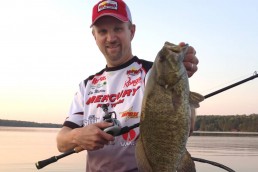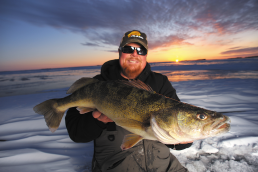Wide-open approach to Smallmouth Bass
SHARE THIS POST
I remember 20 years ago when I decided to get serious about catching smallmouths. I did my homework first, and then started the on-the-water training. I was wide open to learning and was taking it all in to better understand this fascinating finned creature. I guess it was in my blood, because long before I was part of this world dad had spent a lot of time on good smallmouth lakes, namely the boundary waters and other pristine lakes of northern Minnesota pursuing the smallies via canoe.
The common thread to my research was to be ultra-stealthy in the approach and bait choice. For instance, in clear water I’ll use natural colors. Remember to not spook the fish and to always be quiet and move slowly. Stay quite a distance away from a suspected area too and make long casts.
This common advice turned out to be sage advice. As I followed it I became more confident, as it did pay off on the clear-water lakes of central and northern Minnesota as well as Rainy Lake. If the fish were occupying a shallow-water hump, I’d stop the outboard a ways from it. I would then deploy the trolling motor and slowly slip toward the humps with my trolling motor, all the while making very long casts.
When my Storm Chug Bug finally arrived in the strike zone it would get smashed before the ripples faded away. Then the fight was on. And after a few heart-pounding minutes we’d slide the net underneath the “acrobat,” if we were lucky.
But if you pay close attention during a fight, you will notice a few things. Often, if that hump were occupied with a school of bass, then they would follow the hooked one and attempt to steal the bait from its mouth. Sometimes you would catch two on the same lure. As the commotion went on, all the active fish would come to the edge of the boat. Once they saw the boat they seem to disappear into the depths below. With all those active fish around you’d think it would’ve been easy to catch them like never before.
It turns out to be the opposite.
Are you enjoying this post?
You can be among the first to get the latest info on where to go, what to use and how to use it!
There could’ve been 20 fish; it didn’t seem to matter. You could try for 30 minutes with all kinds of different techniques and lures and still no other fish would be interested. You know that they are there, but why won’t even one more of them bite now? It’s definitely a head-scratcher.
After this happens time after time, you then have to wonder if you can capitalize and catch one of the buddies that come up to the boat. And sure enough, with all that commotion below, some of the other bass do hit the baits that are right down there, and quickly. But surely they must see the boat too. So, as this technique is successful more and more all over the Upper Midwest, it does throw a little wrinkle in the “ultra-stealthy” approach.
Once while prefishing for the Canadian Bass Championship on Rainy Lake, my partner and I found a good school of fish along a significant shoreline. Calm, sunny conditions allowed us to watch as the school of bass literally followed us down the bank as we trolled. The boat didn’t scare them away; it almost attracted them to it. I’m not sure if it was the stainless steel prop reflecting in the water as it slowly turned as we went or what. But as we recognized this we were able to catch some of these followers using various techniques. Then all of a sudden there was a fight to be the guy in the back of the boat. This was yet another wrench thrown in to the stealthy method.
There are also times during the year that you can catch bass directly under a boat. And I’m not talking about fishing bedding bass or drop-shotting real deep; I’m referring to 8 to 12 feet of water. There seems to be a little comfort factor (distance) that smallies need to be in in order to bite. When they are in these depths, sometimes the best cast is one that falls next to the boat. Lifelike lures such as the Northland Mimic Minnow, hair jigs such as the VMC DM Marabou Jig, or small Impulse tubes, will all work. Thus, making more ways and to catch a smallmouth bass pretty much wide open. Remember, they have amazing eyesight, can cover the water column with ease and are generally willing to bite.
The best thing you can do is to be prepared and adapt every single time you’re on the water. Sure there are times that the jerkbait works great on the proverbial windy point, but I’ve also seen poppers kill them while the lake was rolling from the wind. I’ve also seen crankbaits work when there was a flat calm and it was sunny. I’m not saying be completely random in your approach, but do keep an open mind. And if you are in a rut, throw something that you don’t normally do. For instance, my nephew Dylan caught big fish of the tournament throwing more of a largemouth-type bait and color. The Terminator swim jig in their Black and Blue isn’t the typical clear-water smallmouth lure. Clear water screams for natural colors and sizes, but on this calm, sunny day we both were pleasantly surprised with the hefty smallmouth caught.
Again, don’t throw everything you’ve learned out the window, but keep the door open to possibility. This will surely help you become more consistent each time you face a new day on the water.
Did you enjoy this post?
You can be among the first to get the latest info on where to go, what to use and how to use it!
Steve Mattson
Steve Mattson has been writing articles for MidWest Outdoors since 2001. He is a driven angler, guide and sponsored tournament pro who has won both bass and panfish tournaments, and has placed in walleye and pike events. He resides in northern Minnesota and enjoys helping others catch more fish. For more info: mattsonangling.com and @mattsonangling.

